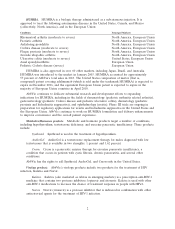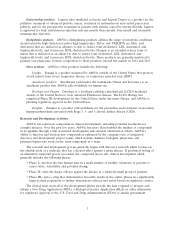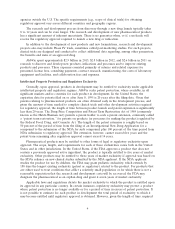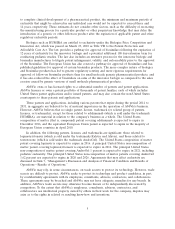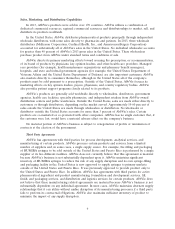AbbVie 2013 Annual Report Download - page 16
Download and view the complete annual report
Please find page 16 of the 2013 AbbVie annual report below. You can navigate through the pages in the report by either clicking on the pages listed below, or by using the keyword search tool below to find specific information within the annual report.Most governments also promote generic substitution by mandating or permitting a pharmacist to
substitute a different manufacturer’s generic version of a pharmaceutical product for the one prescribed
and by permitting or mandating that health care professionals prescribe generic versions in certain
circumstances. In addition, governments use reimbursement lists to limit the pharmaceutical products
that are eligible for reimbursement by national health care systems.
Japan. In Japan, the National Health Insurance system maintains a Drug Price List specifying
which pharmaceutical products are eligible for reimbursement, and the Ministry of Health, Labour and
Welfare sets the prices of the products on this list. The government generally introduces price cut
rounds every other year and also mandates price decreases for specific products. New products judged
innovative or useful, that are indicated for pediatric use, or that target orphan or small population
diseases, however, may be eligible for a pricing premium. The government has also promoted the use
of generics, where available.
Emerging Markets. Many emerging markets take steps to reduce pharmaceutical product prices, in
some cases through direct price controls and in others through the promotion of generic alternatives to
branded pharmaceuticals.
Since AbbVie markets its products worldwide, certain products of a local nature and variations of
product lines must also meet other local regulatory requirements. Certain additional risks are inherent
in conducting business outside the United States, including price and currency exchange controls,
changes in currency exchange rates, limitations on participation in local enterprises, expropriation,
nationalization, and other governmental action.
Employees
AbbVie employed approximately 25,000 persons as of January 31, 2014. Outside the United States,
some of AbbVie’s employees are represented by unions or works councils. AbbVie believes that it has
good relations with its employees.
Internet Information
Copies of AbbVie’s Annual Reports on Form 10-K, Quarterly Reports on Form 10-Q, Current
Reports on Form 8-K, and amendments to those reports filed or furnished pursuant to Section 13(a) or
15(d) of the Securities Exchange Act of 1934 are available free of charge through AbbVie’s investor
relations website (www.abbvieinvestor.com) as soon as reasonably practicable after AbbVie electronically
files the material with, or furnishes it to, the Securities and Exchange Commission.
AbbVie’s corporate governance guidelines, outline of directorship qualifications, code of business
conduct and the charters of AbbVie’s audit committee, compensation committee, nominations and
governance committee, and public policy committee are all available on AbbVie’s investor relations
website (www.abbvieinvestor.com).
ITEM 1A. RISK FACTORS
You should carefully consider the following risks and other information in this Form 10-K in evaluating
AbbVie and AbbVie’s common stock. Any of the following risks could materially and adversely affect
AbbVie’s results of operations or financial condition. The risk factors generally have been separated into
three groups: risks related to AbbVie’s business, risks related to AbbVie’s separation from Abbott and risks
related to AbbVie’s common stock. Based on the information currently known to it, AbbVie believes that the
following information identifies the most significant risk factors affecting it in each of these categories of
risks. However, the risks and uncertainties AbbVie faces are not limited to those set forth in the risk factors
described below and may not be in order of importance or probability of occurrence. Additional risks and
uncertainties not presently known to AbbVie or that AbbVie currently believes to be immaterial may also
12


